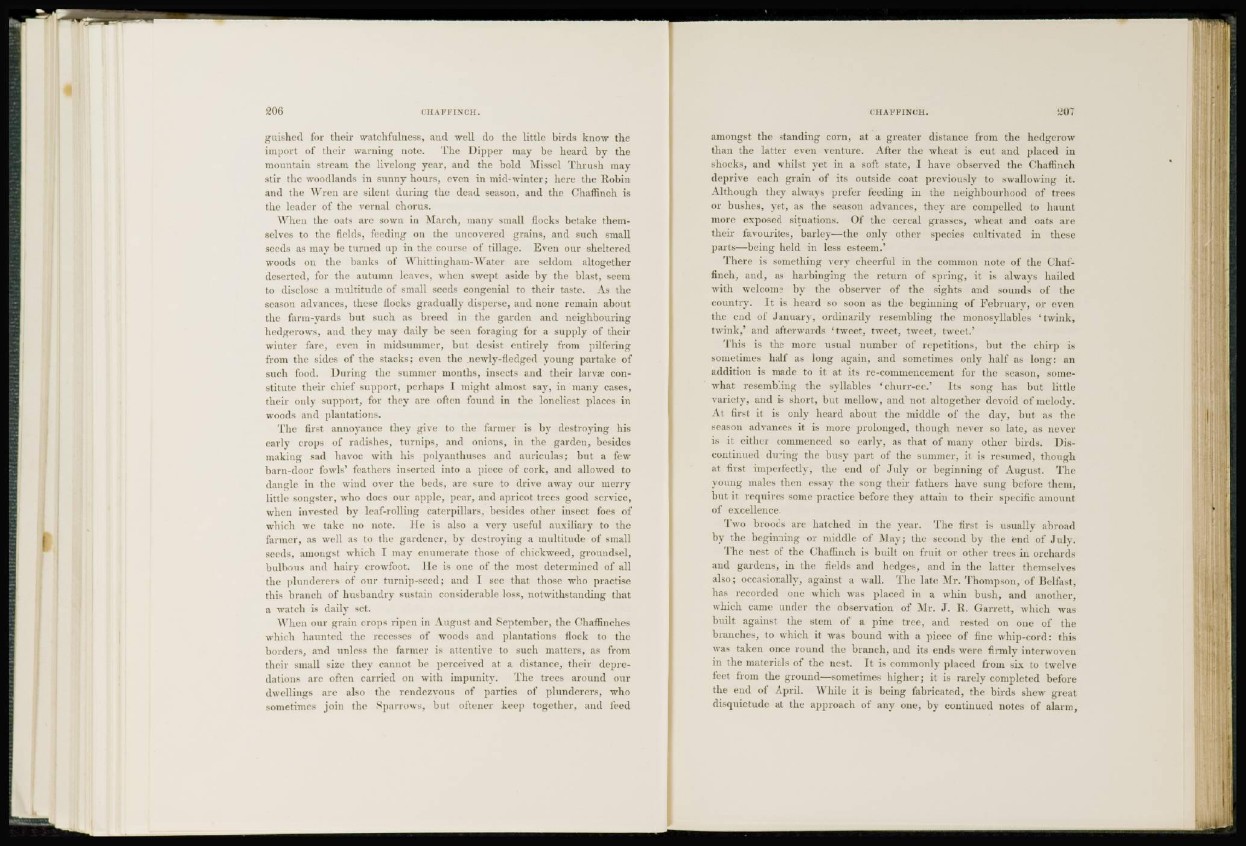
£06 d i LFFINCH.
guished for tlioir watchfulness, and well do the little birds know the
import of their warning note. The Dipper may be heard by the
mountain si ream the livelong year, and the bold Missel Thrush may
stir the woodlands in sunny hours, even in mid-winter; here the Robin
and the Wren arc silent during the dead season, and the Chaffinch is
the leader of the vernal chorus.
When the oats arc sown in March, many small flocks betake themselves
to the fields, feeding on the uncovered grains, and such small
seeds as may be turned up in the course of tillage. Even our sheltered
woods on the banks of W hittingham-Water are seldom altogether
deserted, for the autumn leaves, when swept aside by the blast, seem
to disclose a multitude of small seeds congenial to their taste. As the
season advances, these docks gradually disperse, and none remain about
the farm-yards but such as breed in the garden and neighbouring
hedgerows, and they may daily be seen foraging for a supply of their
winter fare, even in midsummer, but desist entirely from pilfering
from the sides of the stacks; even the .newly-fledged young partake of
such food. During the summer months, insects and their larva? constitute
their chief support, perhaps 1 might almost say, in many cases,
their only support, for they are often found in the loneliest places in
woods and plantations.
The first annoyance they give to the farmer is by destroying his
early crops of radishes, turnips, and onions, in the garden, besides
making sad havoc with his polyanthuses and auriculas; but a few
barn-door fowls' feathers inserted into a piece of cork, and allowed to
dangle in the wind over the beds, are sure to drive away our merry
little songster, who docs our apple, pear, and apricot trees good service,
when invested by leaf-rolling caterpillars, besides other insect foes of
which we take no note. He is also a very useful auxiliary to the
farmer, as well as to the gardener, by destroying a multitude of small
seeds, amongst which I may enumerate those of duckweed, groundsel,
bulbous and hairy crowfoot. He is one of the most determined of all
the plunderers of our turnip-sccd; and I sec that those who practise
this branch of husbandry sustain considerable loss, notwithstanding that
a watch is daily set.
When our grain crops ripen in August, and September, the Chaffinches
which haunted tin- recesses of woods and plantations hock to the
borders, and unless the farmer is attentive to such matters, as from
their small size thev cannot be perceived at a distance, their depredation
are often carried on with impunity. The trees around our
dwellings are also the rendezvous of parties of plunderers, who
sometimes join the Sparrows, but of tener keep together, and feed
CHAFFINCH.
amongst the standing corn, at a greater distance from the hedgerow
than the latter even venture. After the wheat is cut and placed in
shocks, and whilst yet in a soft state, I have observed the Chaffinch
deprive each grain of its outside coat previously to swallowing it.
Although they always prefer feeding in the neighbourhood of trees
or bushes, vet, as the season advances, they are compelled to haunt
more exposed situations. Of the cereal grasses, wheat and oats are
their favourites, barlev—the only other species cultivated in these
parts—being held in less esteem.'
There is something very cheerful in the common note of the Chaffinch,
and, as harbinging the return of spring, it is always hailed
with welcome by the observer of the sights and sounds of the
country. It is heard so soon as the beginning of February, or even
the end of January, ordinarily resembling the monosyllables ' twink,
twink,' and afterwards 'tweet, tweet, tweet, tweet.'
This is the more usual number of repetitions, but the chirp is
sometimes half as long again, ami sometimes only half as long: an
addition is made to it at its re-commencement for (he season, somewhat
resembling the svllables 'churr-ee.' Its song has but little
variety, and is short, but mellow, and not altogether devoid of melody.
At first it is only heard about the middle of the day, hut as the
season advances it is more prolonged, though never so late, as never
is it cither commenced so early, as that of many other birds. Discontinued
during the busy part of the summer, it is resumed, though
at first imperfectly, the end of July or beginning of August. The
young males then essay the song their fathers have sung before them,
but it requires some practice before they attain to their specific amount
of excellence.
Two broods arc hatched in the year. The first is usually abroad
by the beginning or middle of May; the second by the end of July.
The nest of the Chaffinch is built on fruit or other trees in orchards
and gardens, in the fields and hedges, and in the latter themselves
also; occasionally, against a wall. The late Mr. Thompson, of Belfast,
has recorded one which was placed in a whin bush, and another,
which came under the observation of Mr. J. R. Garrett, which was
built against the stem of a pine tree, and rested on one of the
branches, to which it was bound with a piece of fine whip-cord: this
was taken once round the branch, and its ends were firmly interwoven
in the materials of the nest. It is commonly placed from six to twelve
feet from the ground—>ometimes higher; it is rarely completed before
the end of April. While it is being fabricated, the birds shew great
disquietude at the approach of any one, by continued notes of alarm,